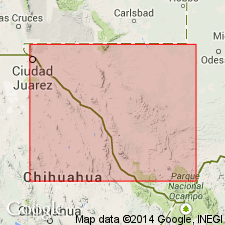
- Usage in publication:
-
- Bone Canyon member
- Modifications:
-
- Original reference
- Dominant lithology:
-
- Limestone
- AAPG geologic province:
-
- Permian basin
Summary:
[Pg. 921-922, 924, 925. See also entry under Delaware Mountain.] Bone Canyon member of Leonard formation. Black limestone, containing fossils of Leonard age, unconformably underlying Delaware Mountain sandstone [basal member of restricted Delaware Mountain formation] in Bone Canyon, on west side of Guadalupe Mountains. A short distance north of Bone Canyon a wedge of gray limestone (here named Victorio Peak member of Leonard formation) appears beneath the unconformity at base of Delaware Mountain sandstone, and separates Bone Canyon member from that sandstone. Thickness 500 to 1,000 feet. Conformably overlies 500 feet of massive limestone containing rich Hess fauna. Age is Permian (Leonard).
Named from Bone Canyon on west side of Guadalupe Mountains, Culberson Co., TX, in Permian basin, where well exposed.
[†Bone Canyon not adopted by subsequent workers. Bone Springs limestone (later Bone Spring) of Blanchard and Davis (1929) is the accepted name. See Bone Spring.]
Source: US geologic names lexicon (USGS Bull. 896, p. 233, Delaware Mountain formation entry, p. 592).
For more information, please contact Nancy Stamm, Geologic Names Committee Secretary.
Asterisk (*) indicates published by U.S. Geological Survey authors.
"No current usage" (†) implies that a name has been abandoned or has fallen into disuse. Former usage and, if known, replacement name given in parentheses ( ).
Slash (/) indicates name conflicts with nomenclatural guidelines (CSN, 1933; ACSN, 1961, 1970; NACSN, 1983, 2005, 2021). May be explained within brackets ([ ]).

